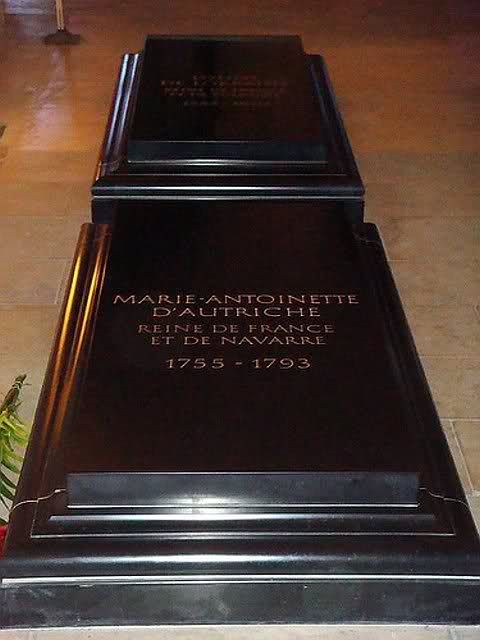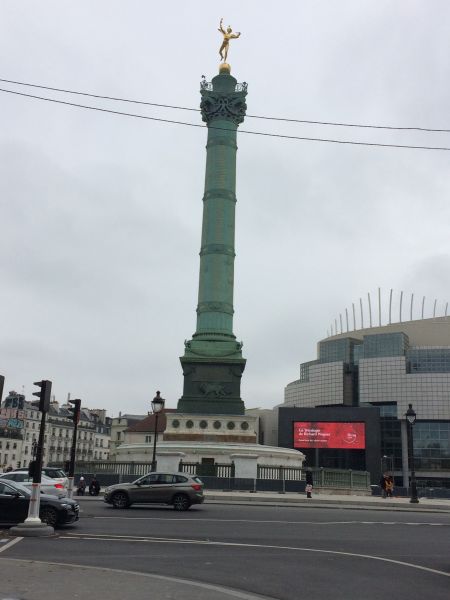By Cathy T
In late October 2019, Cathy A and I took a research trip together to Paris and London. Whilst in Paris we embarked upon a few ‘guided walks’ and although a couple were 18thC related, over the course of the week we fell upon some great 14thC finds!
First day: – Best of French Revolution Walking Tour
In the late 18th century, Paris was the stage where the bloody events of the French Revolution played out, forever altering the course of European history. Layered beneath the bustle and romance of modern-day Paris, traces of the tumultuous events can still be found.
On our first sight-seeing day in Paris, we met our guide outside Le Café de L’Esplanade after warming ourselves with a nice hot cuppa. The tour began with a short walk to what I perceive must be the back or a side entrance to Les Invalides, the war museum (where Napoleon is buried). It’s a huge complex with a domed church.
It was here in 1789 that 30,000 weapons were stolen by protesters at the start of the Revolution but the gunpowder had been moved to a few days beforehand to the Bastille for safe-keeping. This was the reason for the storming of the Bastille – to get the gunpowder needed for their weapons. Releasing the few prisoners left there at the same time was a bonus!
Then onto the Assemblée Nationale building (Lower house of French Parliament) as our guide explained the reasons behind the revolution and what sort of government emerged from the debris.
We crossed over the Pont de la Concorde bridge which we learned is made from the stone of the Bastille after it was pulled down in the revolution.
We walked past the Place de la Concorde where stands eight monumental statues of seated ladies, each representing France’s biggest cities, and a Luxor obelisk- a gift from Egypt. This marks the spot where Louis XVI was beheaded although, the guillotine was moved around the Place de la Revolution (as it was known then) several times because of all the blood. It is thought that where the Lady of Brest sits is where Marie Antionette was beheaded.
Then we hightailed it down the side of the Tulleries gardens, madly snapping shots of the massive bronze statues of a lion and lioness competing for a boar, and a rhinoceros attacking a tiger sculptured by Auguste Nicolas Cain in 1882. A ‘Tulleries’ palace once stood in these gardens, the revolutionaries using the royal chambers as headquarters for their fledgling new government.
We emerged onto the Rue de Rivoli at the St James & Albany Hotel. Once the home of the Dukes of Noailles, its primary historic claim is that it once played host to Marie Antoinette, (from memory up to the night before she was imprisoned).
Scooting past the Louvre, we headed to the intersection of Rue Saint-Honouré and Rue de L’Arbre Sec, in the 1st Arrondissment, where we see a plaque in Latin, dedicated to Louis XVI for his restoration of this fountain which gave free public access to drinking water. Known as ‘Croix-du-Trahoir’ (Cross of Trahoir), the fountain is said to have witnessed public executions and other atrocities committed from the Middle Ages until the 18th century. The fountain owes its name to the fabrics that were pulled out on its steps hence the French word ‘tiroir’ (drawer) which became ‘trahoir.’ An ancient calvary cross used to stand next to the fountain for the condemned to make their final prayers.
We set off again, passing the impressively tall Tower of Saint-Jacques until we came to what is called the Place de Hotel de Ville (City Hall Plaza) but in former times (before 1802) it was called the Place de Grève, the word ‘grève referring to a flat area covered with sand, situated on the shores or banks of a body of water.
We are now standing on the Right Bank and opposite us, across the Seine is Notre Dame. (You can see the two towers side-on in the background of the photo on the left, but alas no spire.) The word ‘grève’ also came to mean ‘strike’ as a place where unemployed people gathered to seek work but one wonders if the ‘strike’ didn’t originally come from the guillotine itself! The day we were there the square held large white tents as though preparing for some event for the coming weekend.
During the French Revolution, the Place de Grève saw the first use of the guillotine. The sandy ground was good for soaking up the blood but eventually there was just too much and the guillotine had to be moved, not only around the ‘Place’ but to entirely new locations. Before it saw the beheading of King Louis XVI and his wife, Marie Antionette in the Place de la Concorde (aka Place de la Revolution), the guillotine had dispensed its justice in the Place de la Nation and the Place de la Bastille as well. This period in history was known as the ‘Reign of Terror.’



On my research trip in 2006, my husband and I visited Saint Denis Basilica and down in the crypt, in the dark, (flash photography used here), we found the royal tombs – no decoration just black with gold engraving.
Next we jumped on the metro at Hotel de Ville, disembarking at the Bastille metro station. Here our guide shows us some more of the original blocks belonging to the erstwhile prison and an emblem of the City of Paris.
The image of a sailing vessel (known as La Nef Parisienne ) has been on the city’s coat of arms since about 1260 when Louis IX, AKA Saint Louis, appointed the Guild of the Watermen to help run the city.
Of course, during the French Revolution all emblems were abolished. But the coat of arms soon resurfaced. Beneath the vessel you usually find the words, “fluctuat nec merigitur” — “tossed by the waves but never sinking” — the motto of Paris. The motto first appeared in the 16th century but was made official by none other than Baron Haussmann in 1853 (French administrator under Napoleon III who transformed Paris from its ancient character to the one you see today, large boulevards connecting to grand boulevards.)
Our guide leaves us here and we climb the stairs to street level and cross the road to see the monument that now resides where the Bastille once stood.
So much blood shed, so many lives lost yet it wasn’t the first revolution that started out with good intentions but ended up turning radical and violent. After the king’s execution, tension in the National Convention resulted in an internal power struggle – the Jacobins against the Girondins. Control passed to the Committee of Public Safety of which Robespierre, a major player in the monarchy’s downfall, became a dominant, dictating force, until finally he, in his turn, was overthrown and executed – on the guillotine no less!
And so ended out first walking tour around Paris. With much to mull over, we chose a cafe across the road from the monument, and for a short time, did what Paris is famous for – sat with refreshment and ‘people watched’!

Catherine A Wilson co-writes with Catherine T Wilson (no relation). Their first book, The Lily and the Lion, was based upon their true-life accidental meeting and resulting friendship. All four books in their ‘Lions and Lilies’ series have won first place prizes in the Chatelaine/Chaucer Awards in the US and in 2019, The Traitor’s Noose won the Grand Prize Chaucer Award.
The Lily and the Lion – 1st Place Chanticleer Chatelaine Award – 2014
The Order of the Lily – 1st Place Chanticleer Chatelaine Award – 2015
The Gilded Crown – 1st Place Chanticleer Chaucer Award – 2016
The Traitor’s Noose – Grand Prize WINNER Chanticleer Chaucer Award – 2017







































